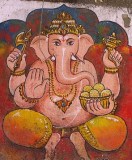Goodness, how times flies in the summer! I just returned home after ten days in Portland, Oregon, enjoying the July 4th festivities as well as the wedding of some dear friends, Chris and Suji. It was blissful for this Pitta gal to wake up to temperatures in the 60’s!
While traveling, I was honored to be included in a survey of Ayurveda experts on the hot topic of juicing by fellow blogger Nadya Andreeva. There is a lot to say on the subject – and perhaps the best advice is that, as in all things viewed through the lens of Ayurveda, the wise choice depends on one’s constitution, the climate, one’s current state of balance and digestive strength. Our responses to her questions were included on two different blog posts: SpinachandYoga.com, and MindBodyGreen.com. Thanks, Nadya, for the opportunity to share my two cents.
* * * * * * * * * *
And now, back to Ayurveda summer school! In my last Foundations post, I described the main qualities of Pitta dosha (the energy of Fire and Water): oily, sharp, hot, light, smelly, spreading, and liquid.
In human beings, Pitta’s primary responsibility is to coordinate digestion and healthy temperature. When Pitta is in balance (i.e., when it is maintained at the original baseline level set at an individual’s birth), then that person’s digestion and ability to manage internal heat are normal.
When Pitta dosha gets elevated, however, then signs of excess heat begin to show up. Fever, inflammation, irritation, hot flashes, diarrhea, ulcers, burning sensations, and skin rashes are all common signs of aggravated Pitta.
In the mind and heart, high Pitta can lead to anger, irritation, annoyance, jealousy, competitiveness, or simply a shorter fuse than usual.
What causes Pitta dosha to go up? As previously discussed, exposure to Pitta’s qualities (in the immediate environment, in foods consumed, or in the mind) will cause Pitta to rise in accordance with the law of “like increases like.” Watch out for greasy, acidic, and pungent-spicy foods, alcohol, hot temperatures, competitive activities, exposure to bright sunlight and overworking, which can all cause Pitta to rise.
During the particularly hot season of summer, Pitta tends to become elevated naturally. There is also a natural surge of Pitta during our mid-adult years when we are responsible for establishing our careers and making our mark on the world. With the emphasis on accomplishment and rational thinking in our culture, Pitta elevation can easily occur anytime.
The best “medicine” for Pitta contains or expresses its opposite qualities: dry, dull, cool, heavy, stable, and dense. Given that it’s mid-summer here in the Northern Hemisphere, now is a good time to drink cooling coconut water, hibiscus tea, pomegranate juice, and organic milk, to schedule in periods of rest (and actually follow through on it!), and to find a shady spot by a pool of cool water.
The trickiest part of managing Pitta is to keep our inner heat under control without putting out our digestive fire, or agni. Drinking ice cold beverages while eating a meal, for example, or piling on the ice cream after a meal, will disrupt digestion entirely. Extremes of cold cause constriction of vessels internally, which is why we ice an injury – to reduce inflammation. When we are trying to digest, however, it is helpful to keep vessels dilated with foods and liquids that are warm.
In the next post, we will begin to explore Kapha dosha, the energy of Earth and Water.


